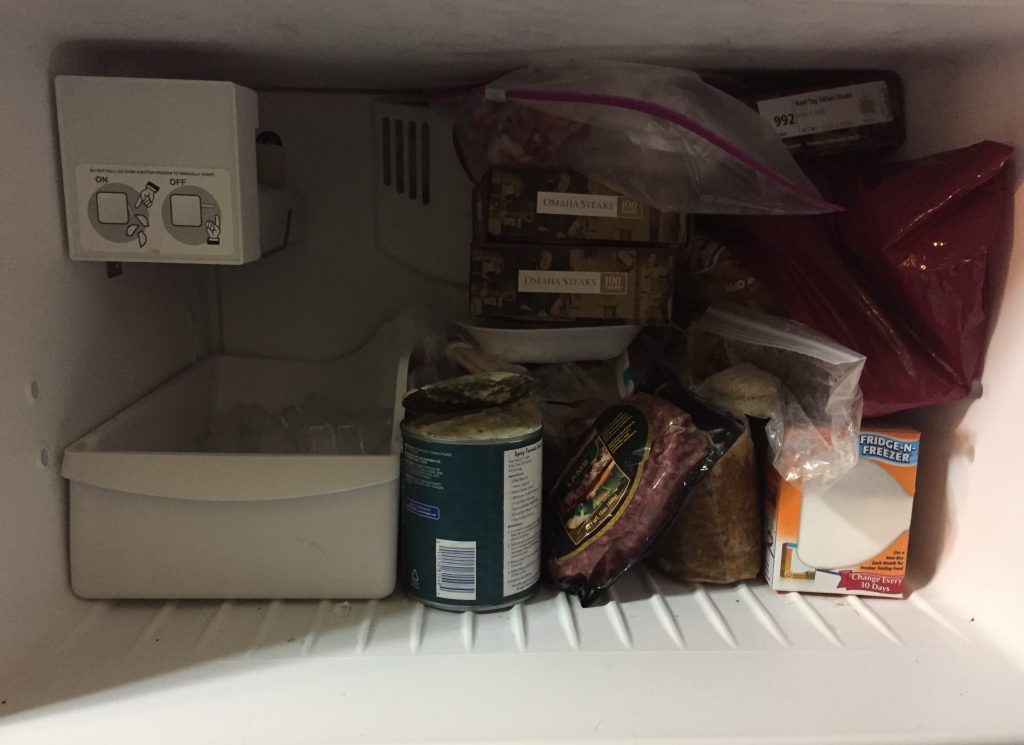
If my fridge has at times been the place where leftovers go to die, my freezer is a crypt of good intentions. Meat that languished in my fridge until the sell-by date? Into the freezer! Herbs that sprouted too abundantly on my porch? Freezer. Cookies I was too tempted to eat right away? You guessed it, although the cookies are now almost gone. The truth is that if you don’t have a freestanding deep-freeze, your freezer is probably either (a) empty; or (b) a time capsule. After a certain amount of trial and error, here are some ideas that can help you make the most of this space:
DO use your freezer for meats, but don’t kid yourself: refrigerated meat will always look like less hassle than frozen. I love shopping the discounted meats at our grocery stores, and I’ve saved a lot of money by purchasing something with the label, “Use or freeze by [tomorrow],” then sticking it into the freezer as soon as I get home. Consider using your fridge only for meat you will consume in the next two days and your freezer for everything else, and take the time to repackage bulk purchases such as chicken breasts or ground beef into individual cling-wrapped portions before freezing. But remember to keep the contents of your freezer in rotation: again, fresh meat will always look easier than frozen, and if your most recent purchases go straight to your plate, your frozen ones can accumulate freezer burn when you aren’t looking.
DO use your freezer for berries, bananas, and peaches. A handful of berries can go a long way when you need an extra element for a salad, and of course you can use them at any point for a smoothie. Buy them on sale when you find them and freeze them individually before transferring to storage bags, so they won’t stick together.
DO freeze individual portions of spaghetti or pizza sauce. Whether store-bought or homemade, you’re almost certainly going to have more than you need for a single use. Rather than storing the extra in your fridge, where it can mold in a matter of weeks, freeze 1-cup portions in Ziploc bags, labeled with the date.
DO freeze pre-sliced bread and homemade pizza dough. There are many excellent pizza dough recipes out there, but they normally make enough for two or three pizzas apiece. The dough freezes and thaws well, if you stick it in the fridge on the night before you’re planning to use it. Sandwich bread also reheats in the toaster oven with no discernible difference from fresh, so I usually place large loaves into the freezer as soon as I bring them home. (The exception is crusty loaves such as French bread, which never last long around here.)
ONLY freeze fresh herbs IF you’re going to chop them first. I’ve tried freezing whole herbs, and I’ve also referenced it in an earlier post, but if your freezer space is at a premium, forget it. As with meats, fresh will always look better than frozen, and it’s just as easy to dry the herbs before they wilt: tie the stems together and suspend them upside down from a hook. However, if you chop the herbs and freeze them with some olive oil in an ice cube tray, you’ll have easy-access individual portions for the next time you need them.
DO freeze nuts, homemade granola, and coffee beans if you have an excess. You can keep these in your fridge or even on your counter just as easily, but your freezer will keep them fresh for the longest amount of time. If you have a surplus, stash some of it here.
ONLY freeze pancakes, waffles, etc. IF you plan to eat them within a week. They reheat well after a couple of days and can be a great way to make a meal in advance, but any longer and you might forget that they’re there.
DO freeze extra portions of soup and bone broth, but limit how much you keep on hand at one time. I store stock in 2-cup portions and soup in individual servings measured by ladle. I find that I tend to use frozen broth more readily than frozen soup, but this is once again a matter of knowing your own habits.
ONLY freeze fresh vegetables IF you’re willing to endure some trial-and-error. Most fresh vegetables require that you blanch them before you freeze them, which involves boiling them for a short while and then plunging them into a bowl of ice water. It’s easy to over-boil when you first attempt this technique, which can result later in reheated veggies that are somewhat soggy. I’ll offer some suggestions about this method in a future post, but in the meantime, here is a useful link.
DO freeze excess cooking fat that you’re planning to throw out. Keeping it in the freezer means it won’t spill and it won’t smell, and you can dump it easily into the bin on trash day.
DO save room for dessert. As my aunt has reminded me, you’re less likely to eat sweets when they’re out of sight. But it never hurts to have ice cream on hand. 🙂


